Birth data cleanup
Work in progress
In this post I clean up some data on daily birth numbers in the Netherlands and Belgium. When our daughter was born, it was very busy, lots of babies were born. This was told to us independently by doctors, nurses and other professionals in babies. So I started thinking about the variance in the number of babies that are born in a time period. It would be nice to have the number of babies born each day (each hour!) in Amsterdam, but I could only find data from the Netherlands, and also daily data from Belgium, which I include as well for later reference.
The original data can be found through the links below. In this post I clean up the data and I include some initial exploration. The clean files, and this notebook, can be found on my GitHub.
- http://statline.cbs.nl/Statweb/publication/?DM=SLNL&PA=70703ned&D1=0&D2=a&HDR=T&STB=G1&VW=D
- http://statbel.fgov.be/nl/statistieken/opendata/datasets/bevolking/
The goal is to later do some research on the technical topics of Gaussian Processes and overdispersion. The research questions I have in mind for now are
- How much clustering is there in the number of babies that are born? How much of that can we explain with seasonal patterns?
- Is there evidence that an expanding economy or job market has something to do with the number of babies born?
- What are the slow-moving and fast-moving trends in this data?
## usual prerequisites
import pandas as pd
%pylab inline
Populating the interactive namespace from numpy and matplotlib
/home/gijs/anaconda3/lib/python3.6/site-packages/IPython/core/magics/pylab.py:160: UserWarning: pylab import has clobbered these variables: ['axes']
`%matplotlib` prevents importing * from pylab and numpy
"\n`%matplotlib` prevents importing * from pylab and numpy"
## data is downloaded locally but can found through the links provided
daily_ned = pd.read_csv("./data/Bevolkingsontwikkeli_171217121849.csv",
encoding="latin-1",
delimiter=";",
skiprows=[1, 2, 3, 4]).reset_index()
daily_ned.columns = ["datum", "births"]
daily_ned.geboortes = pd.to_numeric(daily_ned.births, errors = "coerce")
daily_ned.head(7)
| datum | births | |
|---|---|---|
| 0 | Totaal januari 1995 | 16436.0 |
| 1 | Zondag 1 januari 1995 | 368.0 |
| 2 | Maandag 2 januari 1995 | 439.0 |
| 3 | Dinsdag 3 januari 1995 | 529.0 |
| 4 | Woensdag 4 januari 1995 | 569.0 |
| 5 | Donderdag 5 januari 1995 | 565.0 |
| 6 | Vrijdag 6 januari 1995 | 573.0 |
## removing the total columns and converting the numbers to ints
daily_ned = daily_ned[~daily_ned.datum.str.lower().str.contains("totaal")].dropna()
daily_ned.births = daily_ned.births.astype(int)
daily_ned.sample(10)
| datum | births | |
|---|---|---|
| 585 | Vrijdag 12 juli 1996 | 589 |
| 4510 | Donderdag 21 september 2006 | 570 |
| 7210 | 2013 dinsdag 1 oktober | 573 |
| 3065 | Maandag 23 december 2002 | 591 |
| 6821 | 2012 donderdag 20 september | 559 |
| 5258 | Zaterdag 30 augustus 2008 | 453 |
| 5803 | Zaterdag 23-1-2010 | 461 |
| 2805 | Maandag 15 april 2002 | 515 |
| 6021 | Zondag 22-8-2010 | 422 |
| 5828 | Dinsdag 16-2-2010 | 534 |
daily_ned.births.plot.hist(bins = np.arange(100, 800, 10),
title = "Histogram of daily births in the Netherlands 1995-2015");
plt.grid(True)
plt.ylabel(f"Frequency, N = {len(daily_ned)}")
plt.xlabel("Binsize equals 10");
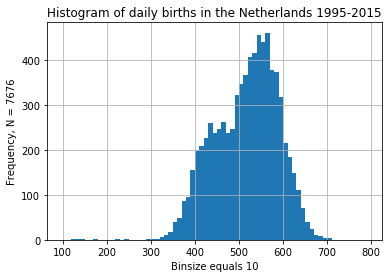
The distribution of dates looks insteresting with two bumps and some weird outliers. Looks like I retrieved the original data anyway.
Parsing the dates
Not only is the date format very nonstandard, there are three different formats used. This is from CBS, the official supplier of statistics in the Netherlands. If I was completely certain the dates are in order, and nothing is missing, just generating a new daterange is much quicker, but I chose to just deal with it and parse all the dates.
## first format
fmt_yd = daily_ned.datum.str.extract("(?P<year>\d{4}) [a-z]{6,10} (?P<day>\d{1,2}) (?P<month_named>[a-z]{3,11})", expand = True).dropna()
fmt_yd[fmt_yd.any(axis = 1)].sample(5)
| year | day | month_named | |
|---|---|---|---|
| 7245 | 2013 | 5 | november |
| 6601 | 2012 | 20 | februari |
| 6869 | 2012 | 5 | november |
| 7271 | 2013 | 1 | december |
| 7190 | 2013 | 11 | september |
To translate the named months to numbers (), I couldn’t find a list of the dutch months in this particular format, so I’ll write them myself. Since the names are in Dutch, if I could somehow set the locale of the date formatting, it would be nice to use a formatting string, but I didn’t find that option. Writing regexes, especially named ones, feels good anyway!
months = ["januari", "februari", "maart", "april", "mei", "juni", "juli", "augustus", "september", "oktober", "november", "december"]
fmt_yd["month"] = fmt_yd.dropna().month_named.astype('category').cat.reorder_categories(months).cat.codes + 1
fmt_yd.sample(5)
| year | day | month_named | month | |
|---|---|---|---|---|
| 6727 | 2012 | 21 | juni | 6 |
| 6797 | 2012 | 28 | augustus | 8 |
| 7951 | 2015 | 31 | augustus | 8 |
| 6241 | 2011 | 15 | maart | 3 |
| 7244 | 2013 | 4 | november | 11 |
In an undocumented feature that I found through GitHub, it is possible to combine columns of parts of dates into a datetime64-series. The alternative would be to use .map or .apply, but that would be much slower. There is no easy way to create an array of datetimes in numpy, which seems a bit weird, but it was alluded to, I believe in the recent announcement of the first ever (…) numpy funding round by the Moore foundation, to be spent by the Berkeley Institute for Data Science.
yd_dates = pd.to_datetime(fmt_yd.drop('month_named', axis = 1))
yd_dates.sample(5)
7602 2014-10-07
6715 2012-06-09
7814 2015-04-16
7763 2015-02-24
7213 2013-10-04
dtype: datetime64[ns]
The same system can be used to extract the other format.
fmt_m = daily_ned.datum.str.extract("(?P<day>\d{1,2}) (?P<month_named>[a-z]{3,11}) ?(?P<year>\d{4})", expand = True).dropna()
fmt_m["month"] = fmt_m.month_named.astype('category').cat.reorder_categories(months).cat.codes + 1
m_dates = pd.to_datetime(fmt_m.drop('month_named', axis = 1))
m_dates.sample(5)
1184 1998-01-28
1140 1997-12-24
5249 2008-08-21
2077 2000-05-26
3240 2003-06-02
dtype: datetime64[ns]
There is also a numerical format which can be parsed easily with a formatting string.
num_dates = pd.to_datetime(daily_ned.datum, format = "%d-%m-%Y", exact = False, errors = "coerce").dropna()
num_dates.sample(5)
5742 2009-12-03
5711 2009-11-03
5840 2010-02-28
5545 2009-05-27
6078 2010-10-16
Name: datum, dtype: datetime64[ns]
daily_ned = daily_ned.assign(date = pd.concat([yd_dates, m_dates, num_dates]))
daily_ned.sample(5)
| datum | births | date | |
|---|---|---|---|
| 7184 | 2013 donderdag 5 september | 492 | 2013-09-05 |
| 1713 | Woensdag 16 juni 1999 | 619 | 1999-06-16 |
| 2798 | Maandag 8 april 2002 | 543 | 2002-04-08 |
| 7800 | 2015 donderdag 2 april | 479 | 2015-04-02 |
| 1415 | Dinsdag 8 september 1998 | 629 | 1998-09-08 |
## There are a couple of `Other` columns
daily_ned[daily_ned.date.isnull()]
| datum | births | date | |
|---|---|---|---|
| 5779 | Overig | 243 | NaT |
| 6549 | Overig | 171 | NaT |
| 6936 | Overig | 131 | NaT |
| 7310 | Overig | 144 | NaT |
| 7696 | Overig | 229 | NaT |
| 8082 | Overig | 121 | NaT |
## remove the unused columns and 'other' rows
## the data is now in the format I want it to be!
daily_ned = daily_ned.dropna().drop('datum', axis = 1, errors = 'ignore').reset_index(drop = True)
daily_ned.to_feather("./data/clean/daily_ned_births.feather")
daily_ned.sample(5)
| births | date | |
|---|---|---|
| 2108 | 547 | 2000-10-09 |
| 6032 | 558 | 2011-07-08 |
| 289 | 547 | 1995-10-17 |
| 7144 | 558 | 2014-07-24 |
| 4410 | 390 | 2007-01-28 |
daily_ned.dropna().date.dt.year.value_counts().sort_index().plot.bar()
plt.ylim((360, 370))
plt.title("Number of observations in each year")
plt.grid();
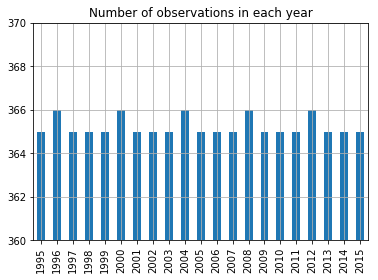
A yes, the extra February 29th each year.
daily_ned[daily_ned.date.dt.year == 2015].set_index('date').births.plot(
title = "Daily births in the Netherlands in 2015"
);
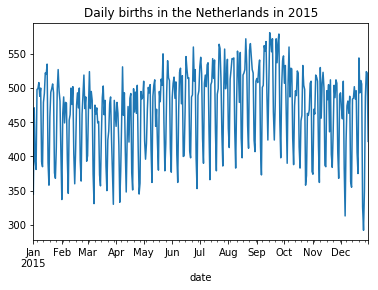
Data from Belgium
The data from Belgium is a bit more recent, but for a shorter period (2008-2016) than the Dutch data (1995-2015). The format is a lot better, without any cruft in there, and normal dateformatting. As a result, the cleaning up is only a couple of steps.
daily_bel = pd.read_csv("./data/TF_BIRTHS.txt", sep = "|")
daily_bel.columns = "date", "births"
daily_bel.date = pd.to_datetime(daily_bel.date)
daily_bel.sample(5)
| date | births | |
|---|---|---|
| 2219 | 2014-01-28 | 408 |
| 2804 | 2015-09-05 | 231 |
| 2634 | 2015-03-19 | 357 |
| 563 | 2009-07-17 | 409 |
| 700 | 2009-12-01 | 388 |
## every year has the correct number of days?
daily_bel.date.dt.year.value_counts().sort_index()
2008 366
2009 365
2010 365
2011 365
2012 366
2013 365
2014 365
2015 365
2016 366
Name: date, dtype: int64
## no duplicated dates ?
daily_bel.date.duplicated().sum()
0
daily_bel.births.plot.hist(
bins = np.arange(150, 600, 10),
title = "Histogram of the number of births per day in Belgium 2008-2016"
);
plt.grid()
plt.xlabel("Binsize equals 10")
plt.ylabel(f"Frequency, N = {len(daily_bel)}");
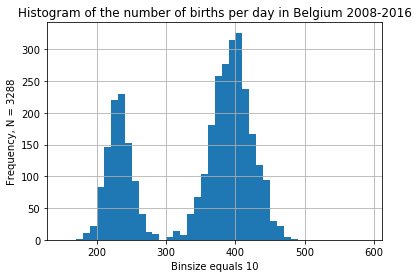
Some overdispersion is to be expected, but this last graph is a bit weird. Perhaps for some years, only the north or the south of Belgium is included in the statistics? Or is it a big weekend effect?
daily_bel.groupby(daily_bel.date.dt.round('20d')).sum().births.plot(
title = "Number of births in Belgium"
)
plt.ylabel("Number of babies born in a 20 day-period");

daily_bel.groupby(
daily_bel.date.dt.weekday_name
).births.plot.density(
legend = True,
grid = True,
figsize = (8, 5),
title = "Density of number of births in Belgium per day for different weekdays"
)
plt.xlabel("Number of babies born per day");
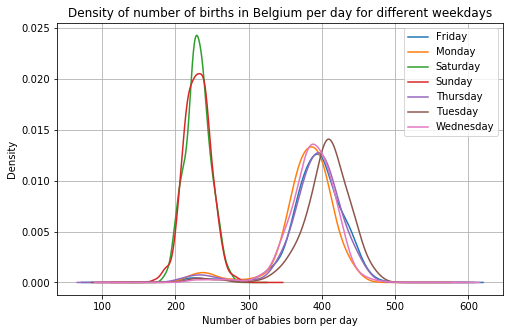
Alright, that’s the weekend effect then. This effect seems to be a lot bigger than in the Netherlands. In the last graph, a density works a bit better than a histogram for comparing the days.
_, axes = plt.subplots(nrows=1, sharex = True, sharey = True, ncols=2, figsize = (12, 5))
daily_bel.groupby(
daily_bel.date.dt.weekday_name
).births.plot.density(
legend = True,
grid = True,
ax = axes[0]
)
daily_ned.groupby(
daily_ned.date.dt.weekday_name
).births.plot.density(
legend = True,
grid = True,
ax = axes[1]
)
axes[0].set_title("Belgium 2008-2016")
axes[1].set_title("Netherlands 1995-2015")
plt.xlabel("Density of daily births");

Densities are always hard to interpret though, especially the height difference here. The point of this graph is to show that there is a large difference between the weekends and the weekdays, and that that effect is stronger in Belgium than in the Netherlands. But you always get more with a graph! The height difference is apparent, which means that there is less variance in the births in Belgium, especially on weekends. This is at least in part because there are less births in belgium anyway, so the variance is less as well.
In addition, there is a difference between sundays and saturdays in the Netherlands. Also some interesting bumps in the lower numbers for weekdays for both countries, perhaps these have to do with festivities? Tuesdays are popular in Belgium, mondays are less popular in the Netherlands. Interesting! I will continue the analysis of these differences in another post.
As mentioned, I want to explore the idea of overdispersion and Gaussian Process regression. Perhaps time series forecasting is also interesting here, especially the evaluation. I just save the data for now. You can find it on GitHub.
daily_bel.to_feather("./data/clean/daily_bel_births.feather")